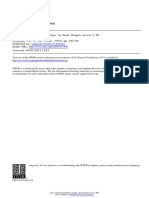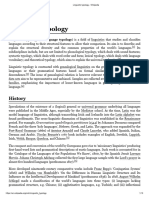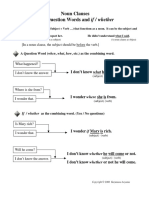Wiley American Anthropological Association
Wiley American Anthropological Association
Uploaded by
Simeon Pol'shinCopyright:
Available Formats
Wiley American Anthropological Association
Wiley American Anthropological Association
Uploaded by
Simeon Pol'shinOriginal Title
Copyright
Available Formats
Share this document
Did you find this document useful?
Is this content inappropriate?
Copyright:
Available Formats
Wiley American Anthropological Association
Wiley American Anthropological Association
Uploaded by
Simeon Pol'shinCopyright:
Available Formats
A Short Description of Item Categories in Iraqw (With Material on Gorowa, Alagwa and
Burunge) by W. H. Whiteley
Review by: Joseph Greenberg
American Anthropologist, New Series, Vol. 61, No. 1 (Feb., 1959), pp. 163-164
Published by: Wiley on behalf of the American Anthropological Association
Stable URL: http://www.jstor.org/stable/666268 .
Accessed: 22/06/2014 16:25
Your use of the JSTOR archive indicates your acceptance of the Terms & Conditions of Use, available at .
http://www.jstor.org/page/info/about/policies/terms.jsp
.
JSTOR is a not-for-profit service that helps scholars, researchers, and students discover, use, and build upon a wide range of
content in a trusted digital archive. We use information technology and tools to increase productivity and facilitate new forms
of scholarship. For more information about JSTOR, please contact support@jstor.org.
Wiley and American Anthropological Association are collaborating with JSTOR to digitize, preserve and
extend access to American Anthropologist.
http://www.jstor.org
This content downloaded from 194.29.185.25 on Sun, 22 Jun 2014 16:25:05 PM
All use subject to JSTOR Terms and Conditions
Book Reviews 163
in the case of Zuni kinship, that it is bilateral (Kroeber 1917), matrilineal (Eggan
1950), bi-functional, though not necessarily coordinate in being either classifying or
role-designating, or both (Schneider and Roberts 1957). It is not, alas, customary for
a general dictionary, like Newman's Zuni, to have anything to say about such special
problems as this-a great pity, for linguists have tools for more analytical probing (not
to mention fieldwork which generally requires longer contact with informants) than
do ethnologists in investigating the same problem. That Newman has not touched on
this controversial problem is no criticism of Newman; rather, it goes to show that the
general dictionary, though indispensable for its special values, can advantageously be
supplemented by particular dictionaries or, more generally, the domain approach in
lexicography, for the sake of other values.
(3) Zuni-English entries in Newman specify parenthetically that a word is a loan
from Spanish or from English or-by absence of parenthesis-that the entry is non-
borrowed Zuni. This part of the dictionary is summarized by Hymes (24 from Spanish,
20 from English), who identifies two additional loanwords from Spanish (Language
34:167-70). It attests the paucity of past acculturation with Spanish Americans and
Anglos; it restricts itself, as is surely usual in a general dictionary, to terms which are
borrowed from another language and which fill a gap or replace a term in the nonbor-
rowed part of the lexicon.
(4) Borrowings in contemporary acculturation, on the other hand, do not fill a
gap or replace a term; they are used side by side with perfectly well known terms in
the nonborrowed part of the lexicon which they enrich (in the sense of gaining some-
thing without losing anything) and for which native speakers have mixed feelings (gen-
erally derogatory). They are not systematically listed in the general dictionary of any
language, and not in Zuni Dictionary. Here a particular dictionary of Zuni borrowings
in contemporary acculturation would be interesting to compare with the work of
others for other languages spoken in the Southwest, as Hale's Papago and our Hopi
(Broken Down Hopi or Enriched Hopi?). Such a particular dictionary is easy to excerpt
from conversational texts. In narrative texts, a Hopi speaker will interrupt himself to
remember a native term; in a later conversation, he will use an English borrowing in
preference to a nonborrowed equivalent.
(5) Stanley Newman remains a master in aligning grammatical patterning. His
first alignment of Zuni is integrated in the heart of the dictionary and preceded by a
half dozen pages of crystal clear exposition. The heart of the dictionary (a thousand
Zuni-English stems pp. 7-49; English-Zuni, pp. 50-108) is followed by an inventory of
about a hundred and fifty affixes (pp. 109-117). Both the preceding and following ma.-
terials are clearly relevant to the main entries and subentries.
A Short Description of Item Categoriesin Iraqw (With material on Gorowa,Alagwa and
Burunge). W. H. WHITELEY.(East African Linguistic Studies No. 3.) Kampala,
Uganda: East African Institute of Social Research, 1958. 75 pp., appendices. 15 s.
Reviewedby JOSEPHGREENBERG,
Centerfor AdvancedStudy in the Behavioral Sciences
As indicated by the title, this work is mainly concerned with the Iraqw language
(likewise known as Mbulu in the literature), a southern Cushitic language of Tangan-
yika of which the author has already given a general description in an earlier publica-
tion in the same series entitled An Introductionto the Study of Iraqw (1954). The present
study is devoted to a detailed treatment of a single aspect of Iraqw grammar with
comparable but not as complete or well verified data for the closely related languages
This content downloaded from 194.29.185.25 on Sun, 22 Jun 2014 16:25:05 PM
All use subject to JSTOR Terms and Conditions
164 American Anthropologist [61, 1959]
of the Gorowa (also called Wa-Fiome), the Alagwa (Wasi), and the Burunge. Concern-
ing these latter three languages, only fragmentary data have hitherto been available.
The grammatical topic discussed is central to the structure of these languages, so
that a detailed treatment is equivalent to a fairly complete grammar. The author has
unfortunately elected to introduce "item" as a new technical term. His discussion of
this matter is extremely confused since there is reference to Bloomfield's classic defini-
tion of the word as a minimal free form, while immediately afterward this unit is called
a "minimal meaningful item" (p. 2)-that is, in American terminology, a "morpheme."
In practice, however, the "items" turn out to be nouns and the "item categories"
are thus noun classes. The discussion includes the noun formations themselves and the
system of agreement with adjectives and with verbs, the latter marked by extensive sets
of selectors which indicate not only the class of the subject, or on occasion the object,
but also tense, mode, and other categories. The volume concludes with five folkloristic
texts in Iraqw accompanied by a literal translation. For linguists interested in this
topic, it may be noted that there are also data concerning permitted sequences of
phonemes in Iraqw.
An Introduction to the Western Desert Language. W. H. DOUGLAS.(Oceania Linguistic
Monographs No. 4.) Sydney, Australia: University of Sydney, 1957. viii, 124 pp.,
appendix. n.p.
Reviewedby ALFRED G. SMITH, Emory University
This language is spoken in the desert areas of "South and Western Australia, in-
cluding the Great Victoria Desert and the Gibson Desert, and in the central west of
the Northern Territory ... This Grammar is an attempt to introduce the student to
any of the dialects of the Western Desert language through . .. a dialect spoken in the
Warburton Ranges area" (i, iv). This is an important undertaking, for there are only a
few, scattered, and perfunctory reports on the speech of this extensive region. Douglas
devoted six years to preparing this study for his fellow missionaries. His diligence is
commendable, but his results leave something to be desired: the all too common need
for professional linguists to supervise lay studies. Our knowledge of languages would
be greatly impoverished without these lay studies, but under skilled guidance they
could enrich us even more.
In the first of the two parts of this monograph, "Pronunciation," the phonetic de-
scriptions are inexact and the phonemic analyses unreal. The discussion is orthographic
rather than phonetic, and the orthography is the one used for all the different dialects
of the language. Thus Douglas maintains that /u/ is phonemically distinct from /u:/,
but the latter occurs only twice in the monograph: once in the contrast that illustrates
this distinction, where the words in the minimal pair come from different dialects; and
once as an illustration of "distortion" with rising intonation. Douglas gives a brief
structural analysis of syllabic stress, but only a semantic analysis of sentence stress
and intonation. In fact, he regards these as matters of punctuation.
The study jumps directly from pronunciation to "Putting the Words Together,"
without considering, "What Words?" There is no morphemic analysis. This second
part of the monograph begins with a distinction between "stimulus sentence type" and
"response sentence type." This is neither a structural nor a semantic distinction, and
has no basis in the Western Desert language. Thus even as a pedagogical device it is
unwarranted. The next distinction is between transitive and intransitive verbs. This
is at best a distinction between the English equivalents of Western Desert expressions.
For any verb in this language there are boun4 morphemes which indicate an object.
This content downloaded from 194.29.185.25 on Sun, 22 Jun 2014 16:25:05 PM
All use subject to JSTOR Terms and Conditions
You might also like
- Basic Color Terms Their Universality and Evolution 1969100% (1)Basic Color Terms Their Universality and Evolution 19693 pages
- Noam Chomsky (Auth.), R. W. Rieber (Eds.) The Neuropsychology of Language - Essays in Honor of Eric Lenneberg 1976No ratings yetNoam Chomsky (Auth.), R. W. Rieber (Eds.) The Neuropsychology of Language - Essays in Honor of Eric Lenneberg 1976234 pages
- Bomhard - A Survey of The Comparative Phonology of The So-Called "Nostratic" Languages (1990)100% (2)Bomhard - A Survey of The Comparative Phonology of The So-Called "Nostratic" Languages (1990)31 pages
- An Introduction To Sociolinguistics. 4th Edition.:an Introduction To Sociolinguistics. 4th Edition100% (1)An Introduction To Sociolinguistics. 4th Edition.:an Introduction To Sociolinguistics. 4th Edition4 pages
- Emailing Linguistic Identityandthe Roleof EbonicsonlinepaperNo ratings yetEmailing Linguistic Identityandthe Roleof Ebonicsonlinepaper16 pages
- The Ecology of Language: Essays by Einar Haugen Anwar S. Dil Review By: J. V. Neustupný Language, Vol. 51, No. 1 (Mar., 1975), Pp. 236-242No ratings yetThe Ecology of Language: Essays by Einar Haugen Anwar S. Dil Review By: J. V. Neustupný Language, Vol. 51, No. 1 (Mar., 1975), Pp. 236-2428 pages
- Cognitive Relativism - Resultative Construction in ChineseNo ratings yetCognitive Relativism - Resultative Construction in Chinese16 pages
- Language_and_Dialect_Atlas_of_Kenya_VoluNo ratings yetLanguage_and_Dialect_Atlas_of_Kenya_Volu2 pages
- West African Pidgin-English: A Descriptive Linguistic Analysis With Texts and Glossary From Lhe Cameroon AreaNo ratings yetWest African Pidgin-English: A Descriptive Linguistic Analysis With Texts and Glossary From Lhe Cameroon Area2 pages
- PHRASEOLOGY, LINGUISTICS AND DICTIONARY AndrewPawleyNo ratings yetPHRASEOLOGY, LINGUISTICS AND DICTIONARY AndrewPawley13 pages
- 2013 - Paradowski - Review Barbara Seidlhofer Understanding English As A Lingua FrancaNo ratings yet2013 - Paradowski - Review Barbara Seidlhofer Understanding English As A Lingua Franca8 pages
- Hieber. 2009. Review of Dying Words (Evans)No ratings yetHieber. 2009. Review of Dying Words (Evans)4 pages
- Schools of Linguistics: Module: Linguistics Level: L2 Teacher's Name: Dr. ADDER Fatima Zohra Unit 2: Lesson TwoNo ratings yetSchools of Linguistics: Module: Linguistics Level: L2 Teacher's Name: Dr. ADDER Fatima Zohra Unit 2: Lesson Two5 pages
- A Study in Language and Cognition - Brown (1954)No ratings yetA Study in Language and Cognition - Brown (1954)9 pages
- In Hot Pursuit of Language in Prehistory. RecNo ratings yetIn Hot Pursuit of Language in Prehistory. Rec5 pages
- Japanese Culture As Reflected Through The Japanese LanguageNo ratings yetJapanese Culture As Reflected Through The Japanese Language9 pages
- Structural Grammar: Nurfaizah Akidah Grammar ENGLISH EDUCATION A (105204014)No ratings yetStructural Grammar: Nurfaizah Akidah Grammar ENGLISH EDUCATION A (105204014)7 pages
- The English Languages by Tom Mcarthur (Review)No ratings yetThe English Languages by Tom Mcarthur (Review)3 pages
- 2000.Linguistic Relativity in Japanese and EnglishNo ratings yet2000.Linguistic Relativity in Japanese and English26 pages
- Cambridge University Press International African InstituteNo ratings yetCambridge University Press International African Institute3 pages
- Language, Culture and Gender AscriptionNo ratings yetLanguage, Culture and Gender Ascription22 pages
- Pedagogy and World Englishes: The Legacy of Yamuna Kachru: AbstractNo ratings yetPedagogy and World Englishes: The Legacy of Yamuna Kachru: Abstract9 pages
- Immediate download Substance and Structure of Language Jaan Puhvel (Editor) ebooks 2024100% (3)Immediate download Substance and Structure of Language Jaan Puhvel (Editor) ebooks 202440 pages
- Approaches To Language Typology - ShibataniNo ratings yetApproaches To Language Typology - Shibatani26 pages
- Difference Between Arabic and English in The Basic Sentence Structure Contrastive Analysis and Typical Translation Errors100% (1)Difference Between Arabic and English in The Basic Sentence Structure Contrastive Analysis and Typical Translation Errors5 pages
- Peperiksaan Percubaan PMR 2009 PKPSM (Malaysia) Kedah0% (1)Peperiksaan Percubaan PMR 2009 PKPSM (Malaysia) Kedah76 pages
- Palabra PARECER: 6 Formas de Usarla: PARECER: Seem, Look Like, AppearNo ratings yetPalabra PARECER: 6 Formas de Usarla: PARECER: Seem, Look Like, Appear1 page
- Admission English: By: Nazmul Huda Dept - of Law, University of Chittagong Phone:01770022470No ratings yetAdmission English: By: Nazmul Huda Dept - of Law, University of Chittagong Phone:0177002247026 pages
- Non-Finite Clause & Clauses Without Verbs: The Catenative Construction & Verbless ClauseNo ratings yetNon-Finite Clause & Clauses Without Verbs: The Catenative Construction & Verbless Clause18 pages
- How To Build A Tree Diagrams Answer Key For Homework and ReviewNo ratings yetHow To Build A Tree Diagrams Answer Key For Homework and Review48 pages
- 1MS - Lesson-One Sequence One By-Sadika-2017-2018No ratings yet1MS - Lesson-One Sequence One By-Sadika-2017-201841 pages

























































































